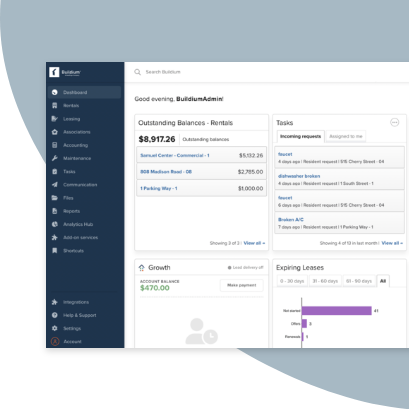Property maintenance consistently ranks among the greatest sources of anxiety for owners and continues to be one of the most sought-after services they look for when hiring a property management company.
Nearly half of the owners we surveyed chose to hire a property manager primarily to handle emergency repairs and preventive property maintenance.
If you’re in the business, that’s probably not a surprise. A well-maintained property attracts more applicants, spends less time vacant, and ups the value of your portfolio.
On the flip side, a property that’s neglected can lead to frustrated residents, headaches for owners, and less desirable listings.
The challenge for an already busy property manager is timing: knowing when to conduct maintenance checks, which repairs to make, and how to prioritize them.
This guide offers comprehensive property maintenance checklists and essential tips and tools to streamline your maintenance process.
Property Management Maintenance Checklist for Year-Round Tasks
A comprehensive property maintenance checklist can vary greatly from one property to another. Your location, property size and type, and the scope of your responsibilities all contribute to what’s on your list.
As a starting point, include these standard repair and maintenance tasks, then add the seasonal items in the next section that are relevant to your property and location.
1. Inspect HVAC Systems
Maintaining a well-functioning HVAC system is a top priority for any property manager. Regular inspections ensure that your heating, ventilation, and air conditioning systems are running efficiently, keeping your tenants comfortable year-round. By scheduling HVAC checks every few months, you can identify and address potential issues before they become costly emergencies.
2. Clean Plumbing Systems
A smoothly running plumbing system is crucial for any property. It’s essential to clean plumbing systems regularly, especially after inclement weather, to check for leaks and clogs. By addressing plumbing maintenance proactively, you can prevent water damage, ensure tenants’ satisfaction, and maintain the integrity of your property.
3. Maintain Electrical Systems
Regular electrical system inspections are paramount for property managers to guarantee the safety of residents and the property itself. Hazardous electrical issues can lead to fire risks and inconvenience for tenants. Make sure you maintain your electrical systems, checking for hazards and outdated wiring.
4. Clean and Inspect Appliances
Keeping appliances in top shape is not only convenient for tenants but also essential for property managers. Regular appliance inspections and maintenance help ensure that these vital amenities remain functional and safe for use. Address issues promptly, as neglect can lead to costly repairs or replacements down the road.
5. Inspect Windows and Doors
Maintaining the integrity of your property’s windows and doors is crucial for security and energy efficiency. Regular inspections to ensure proper sealing, operation, and safety of windows and doors are essential. Keeping the elements out and maintaining a comfortable indoor environment benefits both tenants and property managers.
6. Flooring and Carpet Care
Keeping the flooring and carpets in your property well-maintained is essential for creating a comfortable living environment and protecting your investment. Regularly inspect and address signs of wear and tear. Preventative measures save you from having to deal with costly replacements. Clean and repair when necessary to keep your property in top condition and maintain your tenants’ satisfaction.
7. Outdoor Equipment Maintenance
Outdoor spaces can be a major selling point for your property, but they require regular maintenance. From landscaping and common areas to package delivery rooms and designated storage spots, make sure you provide well-kept outdoor spaces. These amenities enhance the living experience for your tenants and may influence their decision to stay long-term.
8. Outdoor Safety Inspection
Regular outdoor safety inspections involve checking railings, lighting, walkways, stairs, pools, playgrounds, exercise equipment, and security systems. By staying proactive with outdoor safety, you create a secure environment for your residents and reduce the risk of accidents or injuries.
9. Alarm and Extinguisher Testing
Keeping residents safe is a property manager’s responsibility, and regular testing of smoke detectors, carbon monoxide detectors, and fire extinguishers is non-negotiable. By ensuring that these safety devices are functioning properly, you not only fulfill your legal obligations but also provide peace of mind to your tenants.
10. Pest Control Contracts
Pest control is an ongoing concern for property managers, and having reliable pest control contracts in place is essential. Regular pest control measures keep your property pest-free and avoid tenant complaints and potential health issues. By proactively addressing pest control, you protect the well-being of your residents and maintain a positive living environment.
Property Management Maintenance Checklists By Season
Once you’ve got a handle on the typical types of maintenance that keep your property in good shape year-round, start marking your calendar for seasonal repairs.
Here’s a list of what to check on ahead of each season, so you’re not taken by surprise when the weather starts to change.
Spring Property Maintenance Checklist
In many parts of the country, spring can bring some light showers, heavier rain, and even tornados, depending on where you’re located. It helps to conduct an inspection of any damages the past season might have caused, prep for wet weather, and start to prep outside areas for both unexpected weather and the sunnier months ahead.
On the other end of the spectrum, warming weather is also the precursor to wildfire season, so if you’re in a fire-prone area, there are several steps you can take to safeguard your properties.
Wherever you’re located, here are some tasks to cover your bases:
- Clean gutters and downspouts from winter debris
- Inspect roofs for any damage or leaks and repair any crumbling stucco and brick facings
- Clean exterior doors and windows, switching out storm windows for screens
- Landscape and clear yard of debris, including pruning trees and shrubs and planting seasonal flowers
- In fire-prone areas, pay special attention to keep lawns hydrated and remove dry brush and materials that can catch fire easily
- If you’re at an at-risk area for tornados, make sure you have insurance in place (with the appropriate documentation), have contractors in place for potential repairs, and prep your property by clearing debris and investing in storm shutters and impact-resistant windows
- Pressure wash sidewalks, driveways, and exterior of buildings
- Seal driveways and walkways to protect against damages
- Clean and repair decks, patios, and balconies for warmer months
- Set up or repair outdoor lighting fixtures
- Test fire sprinkler and alarm systems
- Inspect sprinkler and irrigation system
- Set thermostats in communal areas to accommodate warmer temperatures
Download the full Spring Rental Property Maintenance Checklist or read our in-depth post.
Summer Property Maintenance Checklist
Prepping for summer is all about keeping your property cool, energy-efficient, and ready for more outdoor use. It’s a good time to invest in curb appeal and make any larger outdoor repairs as needed. If your property is located in an at-risk area, check that your units are prepared for hurricane season. Here are some steps you can take:
- Monitor HVAC systems for efficiency
- Check and repair air conditioning systems to ensure they are running efficiently, scheduling any service ahead of time
- Continue landscaping and lawn maintenance, including watering, mowing, and trimming
- Clean and maintain of any swimming pools and hot tubs
- Paint and touch up exteriors
- Check and repair decks, patios, and balconies
- Test outdoor lighting fixtures
- Replace old weather stripping and caulking around windows and doors
- Check lawn and garden equipment to ensure it is ready for use
- Service outdoor generators and backup power systems
- Remind residents to schedule fall inspections and maintenance services inside their properties, either with your team, or directly with your vendors
- To prep for potential hurricanes, remove debris on your property, take an inventory of outdoor items, and have a reliable line of communication with your residents in place
Fall Property Maintenance Checklist
Your fall maintenance checklist should include weatherproofing your properties and preparing for winter conditions to avoid any difficult, last-minute repairs. Even though conditions vary greatly from region to region, here are steps you can take to be ready for whatever nature throws your way:
- Clean gutters and drainage to prepare for inclement weather
- Winterize plumbing and protect against sleet and freezing rain (for colder, snowy regions)
- Check your HVAC and chimneys for any needed repairs
- Inspect roofing for loose shingles, gaps around vents, and debris
- Prepare a fire safety plan and share residents of seasonal fire hazards such as space heaters and holiday lights
- Take precautionary measures against termites, mice, and other critters
- Protect your entryway and common area floors with absorbent and heavy-duty mats
- Cover or remove window AC units
- Check seals around windows and doors and swap out screens for storm windows
- Landscape selectively to keep your property in good shape for the fall and winter months, including clearing out dead or overgrown brush
- Inspect all carbon monoxide and smoke detectors and replace batteries as needed
- Set thermostats in any common areas for colder temperatures
Winter Property Maintenance Checklist
Winter can be a trying time for your property, especially if you’re located in a colder area. Take these steps ahead of the season to avoid damages and winterize your units:
- Have boilers and furnaces inspected and serviced
- Insulate your pipes (if you haven’t already done so in the fall)
- Set up contracts for snow clearing services before they’re needed
- Clear the past season’s debris from gutters
- Check for pooling and loose shingles on roofs
- Stock up on de-icing chemicals
- Install insulated windows and energy-efficient appliances
- Inspect walls, foundations, and masonry for cracks
- Professionally clean chimneys and flues
- Blow out sprinkler and irrigation systems
- Check carbon monoxide detectors
- Inspect or replace weather stripping
- Remind residents of heater usage and kitchen safety guidelines ahead of the holidays
Property Maintenance Checklists for Safety
In addition to seasonal maintenance tasks, there are regular actions to keep residents and properties safe, as well.
Emergency Plans
For each season, review your emergency plans. Make sure staff is trained and equipment is ready to handle weather-related emergencies common in your area. That may include proper water channeling and sandbags for flooding, branch and brush removal to prevent the spread of fire or damage to roofs from high winds or heavy snow, garage door reinforcement for hurricane-strength winds, or preparing HVAC and plumbing for extreme heat or cold.
Regular Safety Maintenance
We discussed inspecting and repairing certain elements of your properties at certain times of the year. But really, you should schedule regular inspections and maintenance throughout the year for the following issues.
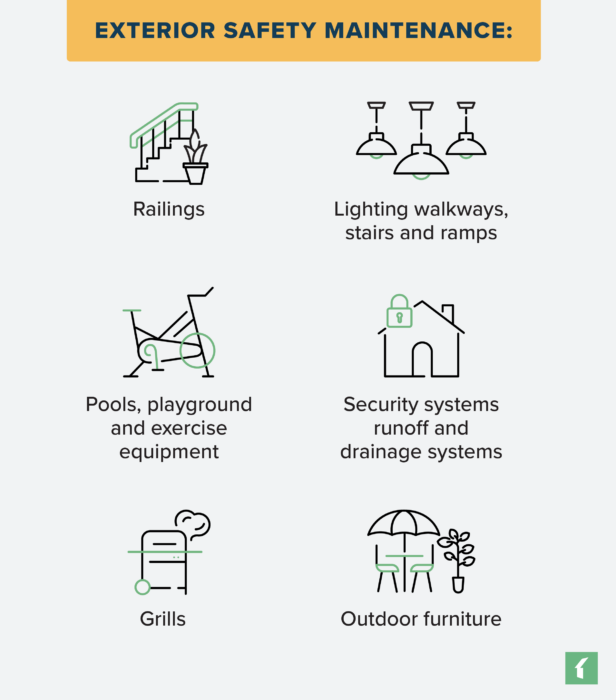
Exterior Safety Maintenance Checklist:
- Railings
- Lighting Walkways, stairs and ramps
- Pools, playground and exercise equipment
- Security systems Runoff and drainage systems
- Grills
- Outdoor furniture
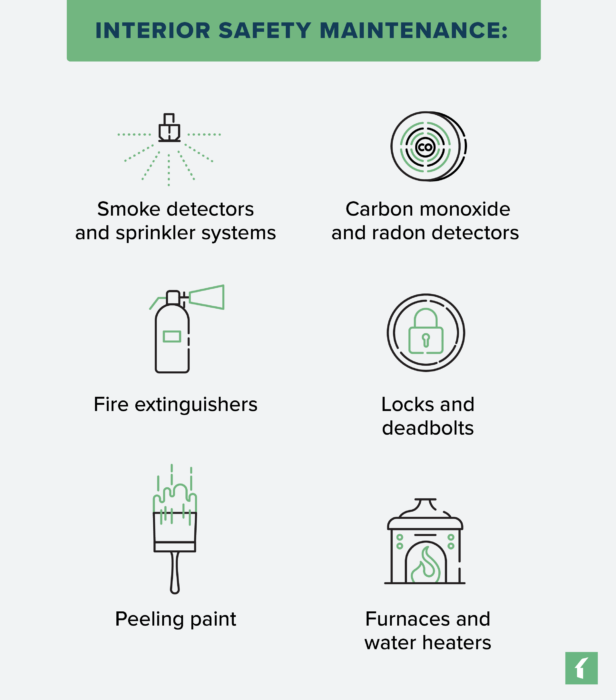
Interior Safety Maintenance Checklist:
- Smoke detectors and sprinkler systems
- Carbon monoxide and radon detectors
- Fire extinguishers
- Locks and deadbolts
- Peeling paint
- Furnaces and water heaters
Stay Ahead of Every Request: The Property Management Maintenance Contact Center
To help you tackle all of these tasks, let’s look at some ways to make maintenance request handling easier. To take some of the burden out of handling service requests from tenants, consider enlisting the help of a maintenance call center.
Buildium’s Maintenance Contact Center is one such solution. The Maintenance Contact Center is a specialized call center service that helps you effectively manage every maintenance request 24/7, log incoming tasks for you in Buildium’s property management platform, and dispatch your preferred vendors in the event of an emergency.
So, how does it work?
Once you get started, you receive a dedicated maintenance number for your business that tenants can call for all maintenance requests. (This also becomes the emergency number that vendors save.)
Professional call center agents take calls 24/7 365 days a year, with a focus on customer experience for your tenants.
Team members take detailed notes on every call and add these notes to the new task they file in Buildium on your behalf.
In an emergency, vendors are dispatched and you will be notified via email.
Some more hands-on property managers may be hesitant to delegate part of your operations to an outside service, but doing so is a proven, reliable way to handle maintenance requests promptly, while retaining full visibility into the process. Agents and the tenant experience stay consistent with your brand and values.
But what about real-world results?
Like many property managers, Christopher Martin, Managing Partner at The Christopher Corporation, used to take a DIY approach to maintenance. Without the staff resources to take and follow up on every call or a way to ensure vendors were completing repairs on time, some requests naturally slipped through the cracks. This began to hurt Chris’ tenant retention and bottom line.
Here’s what he has to say about switching to Maintenance Contact Center:
“The [maintenance] issues just kind of [went] away,” says Martin. “Since we switched it’s been six months and I haven’t had anyone call to say I want to move because of not following up. . . .I could not imagine not having this system in place now. It’s not even an option to not have it. It’s exactly what I was looking for.” -Christopher Martin, Managing Partner at The Christopher Corporation
As you consider technology to assist with maintenance requests, look for options such as the Maintenance Contact Center that save your staff valuable time and keep your tenants happy.
Learn more about Buildium’s Maintenance Contact Center.
How Property Management and Maintenance Go Hand-In-Hand
If you’ve been in the business a while, you know that property upkeep is a task you have to manage daily, whether that’s reaching out to vendors, communicating with tenants, logging work orders, or shopping for new services and upgrades.
Because it’s such a large investment of your time and resources, getting maintenance down to a science can seriously benefit your bottom line (not to mention your peace of mind).
Let’s look at some strategies to stay on top of repair requests before they even emerge.
5 Must-Know Property Manager Maintenance Tips
An effective property management maintenance strategy starts with knowing exactly how you’ll make repairs and which you’ll prioritize. Keep these five tips in mind as you build out your maintenance management plan.
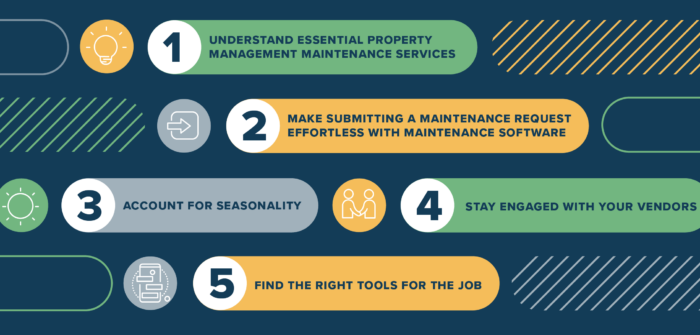
#1: Understand Essential Property Management Maintenance Services
There’s likely dozens of ways a property can be improved, but always prioritize those that may cause a health or safety hazard. That can include anything from fixing loose railings to ensuring all alarms on your property are functioning. You should also always have a plan in place in the event of natural disaster and the appropriate insurance if your property is at risk.
Beyond these immediate risks, you should prioritize any outstanding maintenance requests tenants have made. These issues hit (literally) close to home for your renters. Handling them quickly keeps renters happy and further strengthens your reputation. Simple issues can also snowball into more costly repairs quickly if left unfixed.
Keep in mind that, under the Fair Housing Act, failure to perform or delaying maintenance can be seen as a form of discrimination or retaliation against a tenant. Having an efficient method of completing maintenance requests can help you avoid costly disputes or even legal action down the line.
#2: Make Submitting a Maintenance Request Effortless With Maintenance Software
To alleviate the stress or unexpected repairs for both your team and your tenants, make submitting work orders as simple as possible.
Establish a go-to channel that tenants know they can use to contact you. Many property management companies use email, text, or a web form, but all of those options can get messy quickly.
A resident portal via property management maintenance software can be used to make requests easily, organize them, and track their progress. This is the same interface that tenants can use to pay rent, receive important updates, and field any other type of communication, so there aren’t any additional sites to navigate or hoops to jump through.
It’s also a way for your team to keep tabs on the progress of work orders and access all the relevant details on that particular tenant or unit in a central hub.
Read more: Fielding Communications Without Inundating Your Staff
#3: Account for Seasonality
Changing weather creates new sets of tasks and challenges for property managers, so be sure to account for the ways you’ll need to adapt your property for each new season.
We recommend creating seasonal checklists to supplement your general, year-round checklist. The sections below will show you just what to include in those lists.
For a deeper dive on how to prepare for each season, take a look at our in-depth posts on spring, fall, and winter rental property maintenance.
#4: Stay Engaged With Your Vendors
Strong relationships with vendors translates to high-quality, more cost-effective services for your business. There are a few ways you can build those valuable connections.
First, take a look at your existing contracts and past services from vendors. Do an audit of the most successful working relationships and consider expanding those partnerships as the need arises. Having a way for tenants to share their feedback on work orders can help determine which vendors to expand your contracts with, as well.
Knowing which recurring maintenance tasks you’ll need to complete can also help you line up contracts ahead of time. This can be particularly helpful when seasonal demand for services, such as snow clearing, jumps.
If you have a larger property management company, consider hiring certain specialists (be anything from groundskeepers to plumbers) as employees. You’ll have greater flexibility and control when it comes to regular maintenance or emergency repairs.
#5: Find the Right Tools for the Job
No, we’re not talking about switching between Phillips and flathead screwdrivers. The right tools for property management maintenance are all about technology that helps you get the job done faster and with fewer surprises.
There are all types of tools out there to help you track work orders, process vendor invoices, and communicate with your residents. But, remember, the goal is to reduce your work, not make more of it. That’s why we recommend a comprehensive property management software solution to manage all your repairs, from initial tenant requests to payment (and even 1099 filing) all in one place.
Jump to the end of this guide to see what that platform looks like in action.
What About Upgrades?
There’s always a new buzzworthy amenity or smart home appliance attracting renters’ attention. The upgrades worth investing in, however, are the ones that:
- Attract more applicants and demand higher rental value
- Help you run your properties more efficiently
Many upgrades can actually do both. Smart thermostats, motion-sensing lights and smart bulbs, and upgraded ENERGY STAR-certified appliances such as washer/dryer units, refrigerators, and dishwashers can all cut down on bills while making your units feel more modern and convenient.
Going Green
Especially in the wake of rising energy prices, green and energy-efficient upgrades can result in impressive ROI. These upgrades include:
- Heating and cooling systems
- Hot water heaters
- Proper insulation
- High-performing windows
- Electric appliances
- Winter-proofing and summer-proofing your property
The 2022 Inflation Reduction Act (IRA) gives owners and property managers even more incentives to make energy-efficient upgrades. Specific incentives include:
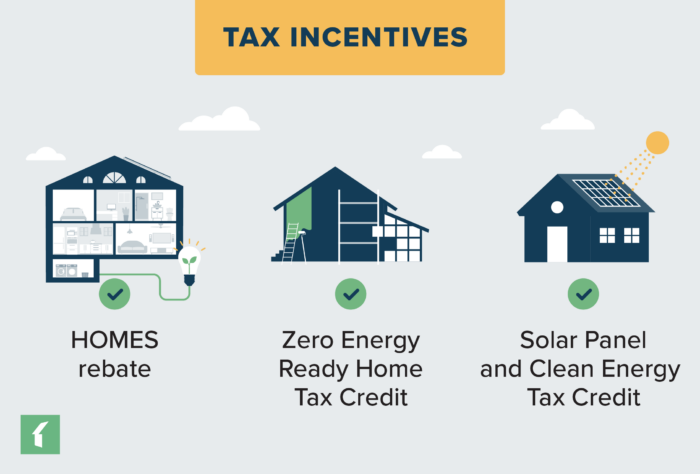
- The HOMES Rebate: Landlords and property managers who are willing to undertake whole-house, energy-saving retrofits are eligible for a rebate based on the amount of energy savings.
- The Zero Energy Ready Home Tax Credit: Developers can receive a $5,000 tax credit for each home they build that meets certain energy-saving requirements.
- The Solar Panel and Clean Energy Tax Credit: Qualifying property managers can receive an energy efficient property credit worth up to 30% of the panel cost for their commercial or residential property, plus an additional 10% if the panels are being installed on a low-income property.
Read more on Eco-Friendly Property Upgrades
For multifamily properties, shared workspaces, common areas, package delivery rooms, designated storage spots, and well-kept outdoor spaces are all amenities that renters value and could be differentiators in their decision to send in an application.
Single-family renters put more of a focus on the safety and convenience of neighborhoods than on particular amenities, although staples such as high-speed Internet and upgraded appliances still make a difference.
Property Maintenance to Retain Residents
Safe, well-maintained properties add value to the resident experience, making them want to stick around for more than one lease cycle. Retaining great residents reduces vacancies and makes owners happy.
You know what else makes owners happy? Few or no surprise repairs. When properties are regularly maintained, fewer emergency repairs pop up. Owners can budget for regular upkeep and don’t have to dip into that emergency reserve fund for a more expensive fix.
That doesn’t mean emergency repairs won’t pop up from time to time. The way you handle those reflects on your company, as well. Set up a system to handle one-off resident requests and urgent maintenance.
Put a quick-response system in place for all requests. The best way to do that is to use the Resident Center in your property management software. Residents can submit requests that you can see in real time. You can then respond with a timeline and turn the request into a trackable work order for your team.
For emergencies, employ a 24-hour answering service that can route calls to you or to an on-call maintenance team.
Outsourcing Property Maintenance Services to Vendors
If yours is a smaller property management firm, or if you manage a large portfolio of properties, you may find you need to outsource some of your property maintenance services.
That may be the case, too, for more specialized maintenance issues, such as furnace or fireplace cleaning, or for occasional issues such as septic tank maintenance and pumping.
Here’s how to find the right one for your properties and create a solid property management vendor list.
Collect Referrals and Conduct Interviews
The best way to find the right professionals to contract with is through referrals from other property management firms. If a lawn care company is doing a great job for one of your colleagues, no doubt they’d be willing to pass on their information.
Once you have two or three good referrals, sit down with each company and communicate to them the exact type of work you need done. Be clear and detailed about the scope, how you would like the work done, and when you would like it done.
Collect Bids
Collect bids from each of the companies you interview and use them to help determine which one you’ll go with.
Pro Tip: Remember, the lowest bid is not always the best choice. You still have to weigh the cost of the work with the quality and reputation of the company.
Sign a Contract
Once you choose a vendor that’s right for you, sit down with them to go over their contract. Make sure everyone is clear on their roles and responsibilities, when work will begin, and when it will end (or if it’s ongoing). Determine when payment will be rendered and what benchmarks need to be hit before you release money.
Sign the contract only when both parties are clear on every aspect and all questions have been answered. The contract should then reflect any changes that came about from your conversation.
Benefits of Property Management Maintenance Software
By now, you should have an extensive maintenance checklist to see your properties through each season and its unique challenges. To handle each of these tasks, you’ll need software you can rely on to keep the progress made on every job organized and viewable in one place.
Property Management Maintenance Tracking Software
Buildium includes simple-to-use maintenance tracking, built into the same platform you can use to run all your property management operations.
In Buildium’s maintenance management feature, each property you manage has its own profile that you can customize by adding preferred vendors and recurring tasks, such as property inspections.
Residents, owners, or employees can also create new maintenance requests directly through their portal and attach any images or videos or documents if needed. At any stage, you can communicate back and forth with other users tied to the request.
Your vendor contracts and invoices are also fully integrated with Buildium’s accounting software, to help make payments and tax reporting faster and more predictable.
![]()
Benefits for Scheduling and Performing Regular Maintenance
Whatever property repairs and maintenance you’re performing, it’s important to keep your residents in the loop. Use push notifications or resident discussion boards to keep everyone informed of upcoming maintenance that could affect the availability of amenities, access to certain buildings or common areas, or parking.
Ahead of any inspections, use the Resident Center to give individual tenants adequate notice and broadly share any updates or reminders relevant to the resident community.
The Owner Portal is a similar tool to keep property owners in the loop of any repairs and costs without overloading them with excessive emails or too many details.
Owners can simply log on to see what you’ve posted and get a quick snapshot of the health of their property.
Frequently Asked Questions
What should be included in a property management maintenance checklist?
A property management maintenance checklist should cover regular inspections, plumbing, electrical systems, HVAC servicing, landscaping, and common area upkeep. Don’t forget to include seasonal tasks like gutter cleaning and snow removal to keep everything in top shape. For a full list, scan the detailed post above.
How often should maintenance checks be performed?
Perform maintenance checks quarterly for a thorough assessment. However, some tasks such as HVAC servicing might need a bi-annual schedule, and landscaping might be more frequent depending on the season. Adjust the frequency based on your property’s specific needs.
How can I handle unexpected maintenance issues?
Set up a reliable process for tenants to report issues promptly. Have a list of trusted contractors you can call for various types of repairs. Responding quickly to unexpected issues helps maintain the property and keeps tenants happy.
What are some cost-effective maintenance tips?
Regularly inspect and clean high-use areas to prevent major issues. Use energy-efficient lighting and appliances to lower utility costs. Schedule routine servicing for HVAC systems to enhance efficiency and lifespan, avoiding costly repairs.
How do I keep track of maintenance tasks?
Use property management software such as Buildium to organize and monitor maintenance tasks. Many programs offer reminders and schedule management features, helping you stay on top of everything without missing important tasks.
Why is tenant communication important in maintenance?
Clear and timely communication with tenants about maintenance schedules and procedures builds trust and cooperation. Inform tenants of upcoming inspections or repairs and provide them with a point of contact for any maintenance-related concerns.


